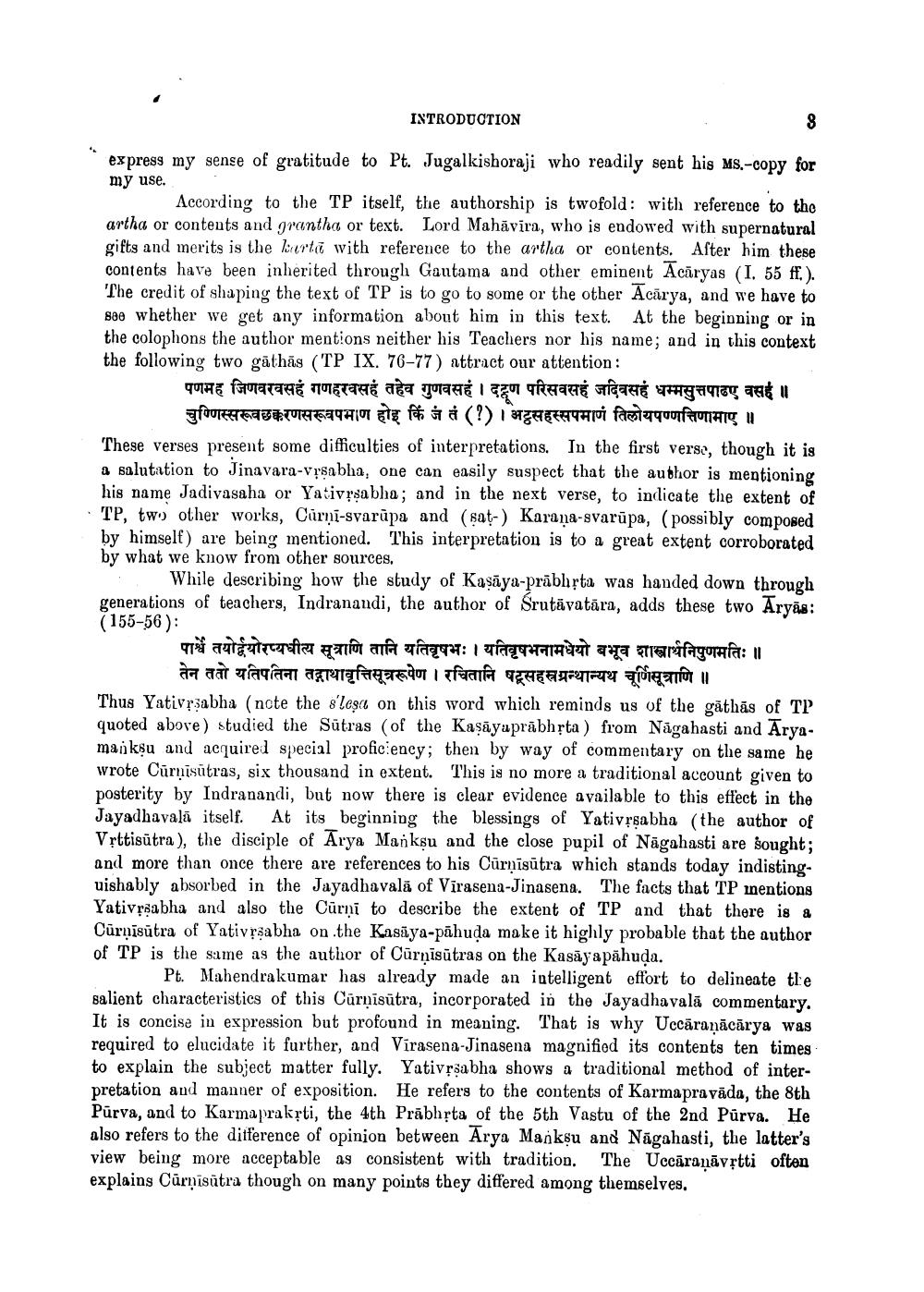Book Title: Introduction Tiloya Pannatti Author(s): A N Upadhye Publisher: A N Upadhye View full book textPage 3
________________ INTRODUCTION express my sense of gratitude to Pt. Jugalkishoraji who readily sent his MS.-copy for my use. According to the TP itself, the authorship is twofold: with reference to the artha or contents and grantha or text. Lord Mahāvīra, who is endowed with supernatural gifts and merits is the kurtii with reference to the artha or contents. After him these contents have been inherited through Gautama and other eminent Acāryas (I. 55 ff.). The credit of shaping the text of TP is to go to some or the other Acārya, and we have to see whether we get any information about him in this text. At the beginning or in the colophons the author mentions neither his Teachers nor his name; and in this context the following two gāthās ('TP IX. 76-77) attract our attention: पणमह जिणवरवसहं गणहरवसहं तहेव गुणवसहं । दट्टण परिसवसहं जदिवसहं धम्मसुत्सपाढए वसई ॥ चुण्णिस्सरूवछक्करणसरूवपमाण होइ किं जं तं (?) । अट्ठसहस्सपमाणं तिलोयपण्णत्तिणामाए ॥ These verses present some difficulties of interpretations. In the first verse, though it is a salutation to Jinavara-Vrsabha, one can easily suspect that the author is mentioning his name Jadivasaha or Yativrsabha; and in the next verse, to indicate the extent of · TP, tw.) other works, Curņi-svarūpa and (sat-) Karana-svarūpa, (possibly composed by himself) are being mentioned. This interpretation is to a great extent corroborated by what we know from other sources, While describing how the study of Kasāya-prābhịta was handed down through generations of teachers, Indranandi, the author of Srutāvatāra, adds these two Aryās: (155-56): पार्श्वे तयोर्द्वयोरप्यधीत्य सूत्राणि तानि यतिवृषभः । यतिवृषभनामधेयो बभूव शास्त्रार्थनिपुणमतिः ॥ तेन ततो यतिपतिना तगाथावृत्तिसूत्ररूपेण । रचितानि षटूसहस्रग्रन्थान्यथ चूर्णिसूत्राणि ॥ Thus Yativrsabha (note the slezet on this word which reminds us of the găthās of TP quoted above) studied the Sūtras (of the Kasāyaprābhṛta) from Nāgahasti and Aryamajkşu and acquired special proficiency; then by way of commentary on the same he wrote Curnīsūtras, six thousand in extent. This is no more a traditional account given to posterity by Indranandi, but now there is clear evidence available to this effect in the Jayadhavalā itself. At its beginning the blessings of Yativrsabha (the author of Vrttisutra), the disciple of Arya Marksu and the close pupil of Nāgahasti are sought; and more than once there are references to his Cūrņīsūtra which stands today indistinguishably absorbed in the Jayadhavală of Virasena-Jinasena. The facts that TP mentions Yativrsabha and also the Cūrņi to describe the extent of TP and that there is a Curnīsūtra of Yativrsabha on.the Kasāya-pāhuda make it highly probable that the author of TP is the same as the author of Cūrņīsūtras on the Kasāyapāhuda. Pt. Mahendrakumar has already made an intelligent effort to delineate tle salient characteristics of this Cūrąīsūtra, incorporated in the Jayadhavală commentary. It is concise in expression but profound in meaning. That is why Uccāraṇācārya was required to elucidate it further, and Virasena-Jinasena magnified its contents ten times to explain the subject matter fully. Yativșsabha shows a traditional method of interpretation and manner of exposition. He refers to the contents of Karmapravāda, the 8th Pūrva, and to Karmaprakrti, the 4th Prābhrta of the 5th Vastu of the 2nd Pūrva. He also refers to the difference of opinion between Arya Mankşu and Nāgahasti, the latter's view being more acceptable as consistent with tradition. The Uccaraṇāvștti often explains Cūrņisūtra though on many points they differed among themselves,Page Navigation
1 2 3 4 5 6 7 8 9 10 11 12 13
